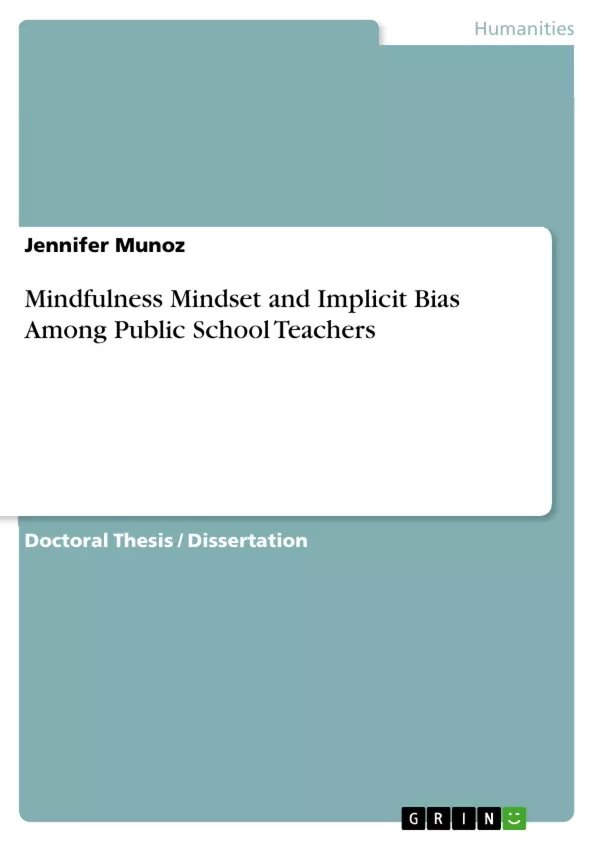Mindfulness skills provide a meaningful and evidence-based means for developing an awareness of unconscious biases, yet further evidence is needed to understand the relationship between specific mindfulness practices and their role in interpersonal interactions. Through the expression of mindful awareness, the development of conscious awareness of bias unfolds, positively affecting interpersonal relationships. This applied culminating project examines the relationship between trait mindfulness and implicit racial bias.
The population for this research study consisted of volunteer public school teachers from within school districts in Southern California during the 2021-2022 academic year. A mixed-methods approach examined the skills of individuals who self-identify as using mindful practices and whether they impact interpersonal relationships.
Inhaltsverzeichnis (Table of Contents)
- CHAPTER I..............
- INTRODUCTION.
- BACKGROUND OF THE PROBLEM OF PRACTICE
- IMPACT OF BURNOUT ON INTERPERSONAL RELATIONSHIPS.
- AUTOMATIC IMPLICIT BIAS..
- CAPACITY FOR CHANGE IN PUBLIC EDUCATION......
- RENDERING COLOR BLINDNESS AMONG EDUCATORS A BYGONE PRACTICE.
- ACCEPTING DISCOMFORT THROUGH COMPASSION AND ALTRUISM..
- CHRONIC STRESS AND RELIANCE ON IMPLICIT BIAS.
- STATEMENT OF THE PROBLEM OF PRACTICE..
- PURPOSE OF THE APPLIED CULMINATING PROJECT
- RESEARCH QUESTIONS
- DELIMITATIONS.........
- SIGNIFICANCE OF THE APPLIED CULMINATING PROJECT.
- DEFINITIONS OF TERMS
- ORGANIZATION OF THE APPLIED CULMINATING PROJECT...
- CHAPTER II REVIEW OF THE LITERATURE
- INTRODUCTION.
- NATURE VERSUS NURTURE..
- THE POTENTIAL FOR OVERRIDING IMPLICIT BIAS.
- AUTOMATICITY.
- DEAUTOMATIZATION AND MINDFUL AWARENESS
- STOPPING THE WANDERING MIND..
- INTERCONNECTEDNESS AND ACCEPTANCE
- DIVERSITY, EQUITY, AND INCLUSION
- LEARNING AND UNLEARNING AUTOMATED INTERPERSONAL BEHAVIORS.
- CULTURAL KNOWLEDGE GUIDES IMPLICIT COGNITION..
- PSYCHOLOGICAL SAFETY AS AN ESSENTIAL LAYER.
- INVITATION FOR INCREASED AND EFFECTIVE DEI LEARNING OPPORTUNITIES
- EDUCATORS AND THE POTENTIAL FOR REDUCING IMPLICIT BIAS ......
- MINDFULNESS MINDSETS AMONGST TEACHERS.
- THE CALL FOR AN ALTRUIST CULTURE AND INNER EQUANIMOUS NATURE
- SUMMARY
- CHAPTER III METHODOLOGY
- IMPLICIT BIASES CREATE INEQUITABLE TEACHING PRACTICES
- PURPOSE OF THE APPLIED CULMINATING PROJECT
- RESEARCH QUESTIONS:.
- RESEARCH METHOD
- POPULATION AND SAMPLE
- MEASURES AND INSTRUMENTATION
- LANGER MINDFULNESS SCALE (LMS)..
- IMPLICIT ASSOCIATION TEST (IAT).
- SUMMARY
- CHAPTER IV FINDINGS
- INTRODUCTION..
- PURPOSE OF APPLIED CULMINATING PROJECT...
- DESCRIPTION OF THE SAMPLE
- DATA ANALYSIS.
- RESULTS OF CHI-SQUARE STAtistical TreaTMENT.
- SUMMARY OF SIGNIFICANT FINDINGS FOR RESEARCH QUESTION ONE.
- DOUBLE LOOP LEARNING OPPORTUNITIES
- ORGANIZATIONAL DISRUPTION
- QUALITATIVE INTERVIEW NARRATIVES.
- SUMMARY OF SIGNIFICANT FINDINGS FOR RESEARCH QUESTION TWO.
- SUCCESSFUL PRACTICES FOR ORGANIZATIONAL DOUBLE LOOP LEARNING
- SUMMARY
- CHAPTER V. _
- SUMMARY, CONCLUSIONS, AND RECOMMENDATIONS
- INTRODUCTION.
- PURPOSE OF THE APPLIED CULMINATING PROJECT.
- RESEARCH QUESTIONS
- SIGNIFICANT FINDINGS.
- INTERPRETATION
- CONTRIBUTIONS TO THE LITERATURE.
- RECOMMENDATIONS FOR FURTHER STUDY
- CONCLUSION.
Zielsetzung und Themenschwerpunkte (Objectives and Key Themes)
This applied culminating project investigates the impact of mindfulness and implicit bias among public school teachers. The project aims to understand the connection between mindfulness practices and the ability to overcome implicit bias in educational settings. By examining the experiences and perspectives of educators, the study seeks to contribute to the development of effective strategies for promoting diversity, equity, and inclusion within schools.
- The role of mindfulness in reducing implicit bias among educators
- The impact of implicit bias on educational practices and student outcomes
- The potential for organizational change and double-loop learning to address implicit bias
- The importance of creating a psychologically safe environment for educators to engage in critical self-reflection and professional development
- The development of effective strategies for promoting diversity, equity, and inclusion in schools
Zusammenfassung der Kapitel (Chapter Summaries)
Chapter I provides a comprehensive overview of the problem of practice, outlining the challenges of implicit bias and its impact on educators and students. The chapter explores the potential of mindfulness as a tool for addressing implicit bias and fostering a more equitable educational environment. Chapter II delves into the existing literature on implicit bias and mindfulness, examining the theoretical frameworks and empirical findings that inform the research. Chapter III outlines the methodology employed in the study, including the research design, data collection methods, and statistical analysis techniques. Chapter IV presents the findings of the study, focusing on the relationship between mindfulness practices and implicit bias among educators. The chapter analyzes the results of the quantitative and qualitative data collected and explores the implications for promoting organizational change.
Schlüsselwörter (Keywords)
This applied culminating project focuses on the key concepts of mindfulness, implicit bias, diversity, equity, and inclusion. The project utilizes empirical research methods, including the Langer Mindfulness Scale (LMS) and the Implicit Association Test (IAT), to examine the relationship between mindfulness and implicit bias among public school teachers. The research explores the potential of mindfulness practices to promote positive change within educational settings, including the creation of a psychologically safe environment for professional development and organizational double-loop learning.
- Arbeit zitieren
- Jennifer Munoz (Autor:in), 2022, Mindfulness Mindset and Implicit Bias Among Public School Teachers, München, GRIN Verlag, https://www.grin.com/document/1274107



